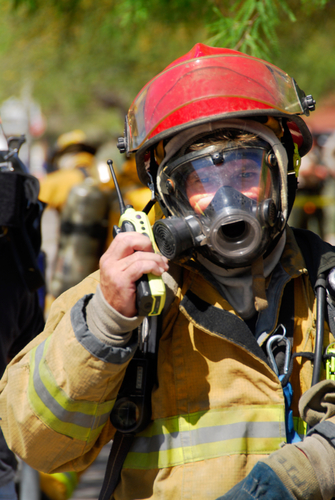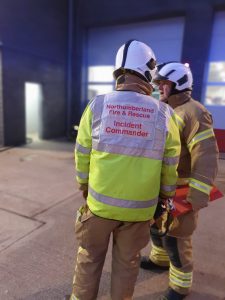Establishing a foundation of communication fundamentals is your first step toward developing fire ground communications that are clear, concise, and disciplined. These fundamentals enable and support all communication models and procedures that build upon the foundation
The 4-Cs of Fire Ground Communication are;
- Connect
- Convey
- Clarify
- Confirm
Connect:
Before you can impart information using a portable radio you must ensure that you are talking to the intended receiver of your message. As the sender you must Connect with the receiver. Consider this flawed radio exchange;
ARFF Commander: “Striker-1, ARFF Command.”
Striker-1 Team Leader: “Go ahead ARFF Command.”
Question: Did the ARFF Commander ‘Connect’ with Striker-1?
Answer: Maybe, maybe not. (Read the exchange again, noting Striker-1’s reply.)
In the previous example, maybe will never solve your fire ground communication problems. True, the
In the previous example, maybe will never solve your fire ground communication problems. True, the ARFF Commander did connect with somebody. However, if somebody is not Striker-1, then the rest of the 4-C cycle could be a waste of time – no matter how clear, concise, disciplined, and meaningful the message conveyed might be. Connecting with the “somebody” could be dangerous. Bad things can happen if you are not connected to, and communicating with, the intended receiver of your message.
Consider the following revision to the previous connection exchange;
ARFF Commander: “Striker-1, ARFF Command.”
Striker-1 Team Leader: “Striker-1.”
Question: Did the ARFF Commander connect with Striker-1?
Answer: Absolutely, yes!
The ARFF Commander is now ready to convey the message and Striker-1 is ready to receive the message. So far so good…
Nobody in your fire department has the radio designator ‘Go Ahead.’ If you want to solve fire ground communication problems, eliminate the use of “Go Ahead”. Go Ahead is unnecessary radio fluff!
Convey:
Having connected with the intended receiver, the ARFF Commander can Convey the message…
ARFF Commander: “Make immediate entry into aircraft via Lima One.”
Note that this message is not conversational; the message is clear, concise, and easy to understand. Conversational radio traffic is an indicator of people thinking with their thumb depressing the mic button.
Conversational radio traffic sounds like this:
“Striker-1, I need you guys to make entry into the aircraft through the Lima One door straight away.”
The conversational words are “I-need-you-guys-to”. Speaking conversational words produces unnecessary radio traffic. Multiply the mouths speaking conversational words and you multiply the conversational radio traffic. Conversational words are not important and unnecessary radio traffic gobbles up valuable ‘air time’ that could be silent.
Silence provides ample room for concise, meaningful, important radio traffic. One of the keys to conveying information with a portable radio is to be clear and concise—not conversational. This means that you think conversationally before you convey concisely.
Clarify:
Striker-1 will now Clarify the message imparted by the ARFF Commander:
Striker-1 Team Leader: “Striker-1 copy, make immediate entry into aircraft through Lima One.”
Question: Does the ARFF Commander know with 100% certainty that Striker 1 heard the correct message?
Answer: Yes, absolutely!
What if Striker 1’s response to the message conveyed by the ARFF Commander was:
Striker 1 Team Leader: “Striker 1 copy.”
Questions: What did Striker 1 ‘copy?’ Does the ARFF Commander know with 100% certainty that Striker 1 heard the message conveyed?
Answer: No, absolutely not!
Without clarification another maybe has emerged. Maybe Striker 1 heard the correct message, maybe they didn’t. The only thing 100% certain is that Striker 1 did hear the ARFF Commander say something. Clarification establishes 100% certainty that the message received is the same as the message conveyed.
Confirm:
Now the ARFF Commander must Confirm that the message clarified is the same message that was conveyed.
ARFF Commander: “Affirmative Striker 1.”
Author:
Used with permission by the author.
Mark Emery is president of Fire Command LLC in King County, WA. He is a graduate of the National Fire Academy’s Executive Fire Officer (EFO) Program and received a bachelor of arts degree from California State University at Long Beach. Emery authored “Integrated Tactical Accountability,” “The Ten Command-ments of Intelligent and Safe Fireground Operations,” “The Fire Station Pyramid of Success,” “Truss Truce,” “Grading the Fireground on the Curve,” “Building Construction: Anatomy of the Structural Fireground” and numerous other articles. He developed programs that include the “ITAC Command Competency Clinic,” “Essentials of Fire Station Leadership” and “Building Construction: Considerations for Informed Fireground Decisions.” In 2010, he retired as an operations battalion chief with the Woodinville, WA, Fire & Life Safety District to pursue his passion for writing, teaching and fire officer development.


